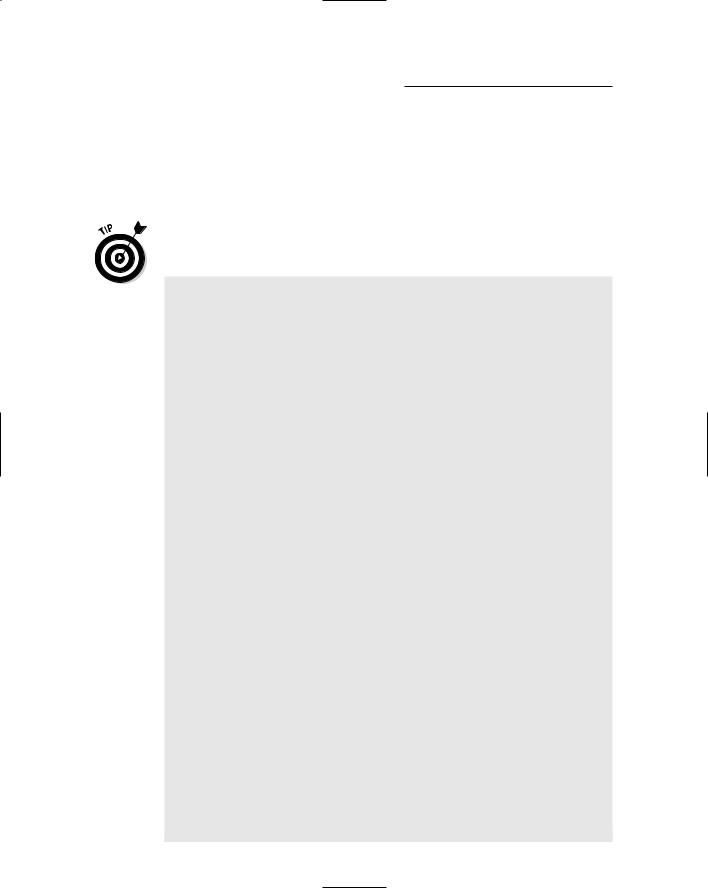
- •Table of Contents
- •Introduction
- •What Is C++?
- •Conventions Used in This Book
- •How This Book Is Organized
- •Part I: Introduction to C++ Programming
- •Part III: Introduction to Classes
- •Part IV: Inheritance
- •Part V: Optional Features
- •Part VI: The Part of Tens
- •Icons Used in This Book
- •Where to Go from Here
- •Grasping C++ Concepts
- •How do I program?
- •Installing Dev-C++
- •Setting the options
- •Creating Your First C++ Program
- •Entering the C++ code
- •Building your program
- •Executing Your Program
- •Dev-C++ is not Windows
- •Dev-C++ help
- •Reviewing the Annotated Program
- •Examining the framework for all C++ programs
- •Clarifying source code with comments
- •Basing programs on C++ statements
- •Writing declarations
- •Generating output
- •Calculating Expressions
- •Storing the results of expression
- •Declaring Variables
- •Declaring Different Types of Variables
- •Reviewing the limitations of integers in C++
- •Solving the truncation problem
- •Looking at the limits of floating-point numbers
- •Declaring Variable Types
- •Types of constants
- •Special characters
- •Are These Calculations Really Logical?
- •Mixed Mode Expressions
- •Performing Simple Binary Arithmetic
- •Decomposing Expressions
- •Determining the Order of Operations
- •Performing Unary Operations
- •Using Assignment Operators
- •Why Mess with Logical Operations?
- •Using the Simple Logical Operators
- •Storing logical values
- •Using logical int variables
- •Be careful performing logical operations on floating-point variables
- •Expressing Binary Numbers
- •The decimal number system
- •Other number systems
- •The binary number system
- •Performing Bitwise Logical Operations
- •The single bit operators
- •Using the bitwise operators
- •A simple test
- •Do something logical with logical calculations
- •Controlling Program Flow with the Branch Commands
- •Executing Loops in a Program
- •Looping while a condition is true
- •Using the for loop
- •Avoiding the dreaded infinite loop
- •Applying special loop controls
- •Nesting Control Commands
- •Switching to a Different Subject?
- •Writing and Using a Function
- •Divide and conquer
- •Understanding the Details of Functions
- •Understanding simple functions
- •Understanding functions with arguments
- •Overloading Function Names
- •Defining Function Prototypes
- •Variable Storage Types
- •Including Include Files
- •Considering the Need for Arrays
- •Using an array
- •Initializing an array
- •Accessing too far into an array
- •Using arrays
- •Defining and using arrays of arrays
- •Using Arrays of Characters
- •Creating an array of characters
- •Creating a string of characters
- •Manipulating Strings with Character
- •String-ing Along Variables
- •Variable Size
- •Address Operators
- •Using Pointer Variables
- •Comparing pointers and houses
- •Using different types of pointers
- •Passing Pointers to Functions
- •Passing by value
- •Passing pointer values
- •Passing by reference
- •Limiting scope
- •Examining the scope problem
- •Providing a solution using the heap
- •Defining Operations on Pointer Variables
- •Re-examining arrays in light of pointer variables
- •Applying operators to the address of an array
- •Expanding pointer operations to a string
- •Justifying pointer-based string manipulation
- •Applying operators to pointer types other than char
- •Contrasting a pointer with an array
- •Declaring and Using Arrays of Pointers
- •Utilizing arrays of character strings
- •Identifying Types of Errors
- •Choosing the WRITE Technique for the Problem
- •Catching bug #1
- •Catching bug #2
- •Calling for the Debugger
- •Defining the debugger
- •Finding commonalities among us
- •Running a test program
- •Single-stepping through a program
- •Abstracting Microwave Ovens
- •Preparing functional nachos
- •Preparing object-oriented nachos
- •Classifying Microwave Ovens
- •Why Classify?
- •Introducing the Class
- •The Format of a Class
- •Accessing the Members of a Class
- •Activating Our Objects
- •Simulating real-world objects
- •Why bother with member functions?
- •Adding a Member Function
- •Creating a member function
- •Naming class members
- •Calling a Member Function
- •Accessing a member function
- •Accessing other members from a member function
- •Defining a Member Function in the Class
- •Keeping a Member Function After Class
- •Overloading Member Functions
- •Defining Arrays of and Pointers to Simple Things
- •Declaring Arrays of Objects
- •Declaring Pointers to Objects
- •Dereferencing an object pointer
- •Pointing toward arrow pointers
- •Passing Objects to Functions
- •Calling a function with an object value
- •Calling a function with an object pointer
- •Calling a function by using the reference operator
- •Returning to the Heap
- •Comparing Pointers to References
- •Linking Up with Linked Lists
- •Performing other operations on a linked list
- •Hooking up with a LinkedListData program
- •A Ray of Hope: A List of Containers Linked to the C++ Library
- •Protecting Members
- •Why you need protected members
- •Discovering how protected members work
- •Protecting the internal state of the class
- •Using a class with a limited interface
- •Creating Objects
- •Using Constructors
- •Why you need constructors
- •Making constructors work
- •Dissecting a Destructor
- •Why you need the destructor
- •Working with destructors
- •Outfitting Constructors with Arguments
- •Justifying constructors
- •Using a constructor
- •Defaulting Default Constructors
- •Constructing Class Members
- •Constructing a complex data member
- •Constructing a constant data member
- •Constructing the Order of Construction
- •Local objects construct in order
- •Static objects construct only once
- •Global objects construct in no particular order
- •Members construct in the order in which they are declared
- •Destructors destruct in the reverse order of the constructors
- •Copying an Object
- •Why you need the copy constructor
- •Using the copy constructor
- •The Automatic Copy Constructor
- •Creating Shallow Copies versus Deep Copies
- •Avoiding temporaries, permanently
- •Defining a Static Member
- •Why you need static members
- •Using static members
- •Referencing static data members
- •Uses for static data members
- •Declaring Static Member Functions
- •What Is This About, Anyway?
- •Do I Need My Inheritance?
- •How Does a Class Inherit?
- •Using a subclass
- •Constructing a subclass
- •Destructing a subclass
- •Having a HAS_A Relationship
- •Why You Need Polymorphism
- •How Polymorphism Works
- •When Is a Virtual Function Not?
- •Considering Virtual Considerations
- •Factoring
- •Implementing Abstract Classes
- •Describing the abstract class concept
- •Making an honest class out of an abstract class
- •Passing abstract classes
- •Factoring C++ Source Code
- •Defining a namespace
- •Implementing Student
- •Implementing an application
- •Project file
- •Creating a project file under Dev-C++
- •Comparing Operators with Functions
- •Inserting a New Operator
- •Overloading the Assignment Operator
- •Protecting the Escape Hatch
- •How Stream I/O Works
- •The fstream Subclasses
- •Reading Directly from a Stream
- •Using the strstream Subclasses
- •Manipulating Manipulators
- •Justifying a New Error Mechanism?
- •Examining the Exception Mechanism
- •What Kinds of Things Can I Throw?
- •Adding Virtual Inheritance
- •Voicing a Contrary Opinion
- •Generalizing a Function into a Template
- •Template Classes
- •Do I Really Need Template Classes?
- •Tips for Using Templates
- •The string Container
- •The list Containers
- •Iterators
- •Using Maps
- •Enabling All Warnings and Error Messages
- •Insisting on Clean Compiles
- •Limiting the Visibility
- •Avoid Overloading Operators
- •Heap Handling
- •Using Exceptions to Handle Errors
- •Avoiding Multiple Inheritance
- •Customize Editor Settings to Your Taste
- •Highlight Matching Braces/Parentheses
- •Enable Exception Handling
- •Include Debugging Information (Sometimes)
- •Create a Project File
- •Customize the Help Menu
- •Reset Breakpoints after Editing the File
- •Avoid Illegal Filenames
- •Include #include Files in Your Project
- •Executing the Profiler
- •System Requirements
- •Using the CD with Microsoft Windows
- •Using the CD with Linux
- •Development tools
- •Program source code
- •Index

Chapter 6
Creating Functions
In This Chapter
Writing functions
Passing data to functions
Naming functions with different arguments
Creating function prototypes
Working with include files
The programs developed in prior chapters have been small enough that they can be easily read as a single unit. Larger, real-world programs can be many thousands (or millions!) of lines long. Developers need to break up
these monster programs into smaller chunks that are easier to conceive, develop, and maintain.
C++ allows programmers to divide their code into exactly such chunks (known as functions). As long as a function has a simple description and a well-defined interface to the outside world, it can be written and debugged without worrying about the code that surrounds it.
This divide-and-conquer approach reduces the difficulty of creating a work ing program of significant size. This is a simple form of encapsulation — see Chapter 15 for more details on encapsulation.
Writing and Using a Function
Functions are best understood by example. This section starts with the example program FunctionDemo, which simplifies the NestedDemo program I discussed in Chapter 5 by defining a function to contain part of the logic. Then this section explains how the function is defined and how it is invoked, using FunctionDemo as a pattern for understanding both the problem and the solution.

80 |
Part II: Becoming a Functional C++ Programmer |
The NestedDemo program in Chapter 5 contains an inner loop (which accu mulates a sequence of numbers) surrounded by an outer loop (which repeats the process until the user quits). Separating the two loops would simplify the program by allowing the reader to concentrate on each loop independently.
The following FunctionDemo program shows how NestedDemo can be simpli fied by creating the function sumSequence().
Function names are normally written with a set of parentheses immediately following the term, like this:
// FunctionDemo - demonstrate the use of functions |
|
// |
by breaking the inner loop of the |
// |
NestedDemo program off into its own |
// |
function |
#include <cstdio> |
|
#include <cstdlib> |
|
#include <iostream> |
|
using namespace std; |
|
// sumSequence - add a sequence of numbers entered from |
|
// |
the keyboard until the user enters a |
// |
negative number. |
// |
return - the summation of numbers entered |
int sumSequence(void) |
|
{ |
// loop forever |
|
|
|
int accumulator = 0; |
|
for(;;) |
|
{ |
//fetch another number int value = 0;
cout << “Enter next number: “; cin >> value;
//if it’s negative...
if (value < 0)
{
// ...then exit from the loop break;
}
//...otherwise add the number to the
//accumulator
accumulator= accumulator + value;
}
// return the accumulated value return accumulator;
}
int main(int nNumberofArgs, char* pszArgs[])
{

Chapter 6: Creating Functions |
81 |
cout << “This program sums multiple series\n”
<<“of numbers. Terminate each sequence\n”
<<“by entering a negative number.\n”
<<“Terminate the series by entering two\n”
<<“negative numbers in a row\n”
<<endl;
//accumulate sequences of numbers...
int accumulatedValue; for(;;)
{
//sum a sequence of numbers entered from
//the keyboard
cout << “Enter next sequence” << endl; accumulatedValue = sumSequence();
//terminate the loop if sumSequence() returns
//a zero
if (accumulatedValue == 0)
{
break;
}
// now output the accumulated result cout << “The total is “
<<accumulatedValue
<<“\n”
<<endl;
}
cout << “Thank you” << endl;
//wait until user is ready before terminating program
//to allow the user to see the program results system(“PAUSE”);
return 0;
}
Defining the sumSequence() function
The statement int sumSequence(void) begins the definition of the sumSequence() function. The block of code contained in the braces is the function body. The function sumSequence() accumulates a sequence of values entered from the keyboard. This code section is identical to that found in the inner loop of NestedDemo.

82 |
Part II: Becoming a Functional C++ Programmer |
Calling the function sumSequence()
Let’s concentrate on the main program contained in the braces following main(). This section of code looks similar to the outer loop in NestedDemo.
The main difference is the expression accumulatedValue = sumSequence(); that appears where the inner loop would have been. The sumSequence() statement invokes the function of that name. A value returned by the function is stored in the variable accumulatedValue. Then this value is displayed. The main program continues to loop until sumSequence() returns a sum of zero, which indicates that the user has finished calculating sums.
Divide and conquer
The FunctionDemo program has split the outer loop in main() from the inner loop into a function sumSequence(). This division wasn’t arbitrary: sumSequence() performs a separate role — worth considering by itself — apart from the control features within FunctionDemo.
A good function is easy to describe. You shouldn’t have to use more than a single sentence, with a minimum of such words as and, or, unless, or but. For example, here’s a simple, straightforward definition:
“The function sumSequence accumulates a sequence of integer values entered by the user.”
This definition is concise and clear. It’s a world away from the ContinueDemo program description:
“sums a sequence of positive values AND generates an error if the user enters a negative number AND displays the sum AND starts over again until the user enters two zero-length sums.”
The output of a sample run of this program appears much like that generated by the NestedDemo program, as follows:
This program sums multiple series of numbers. Terminate each sequence by entering a negative number. Terminate the series by entering two negative numbers in a row
Enter next sequence
Enter next number: 1
Enter next number: 2
